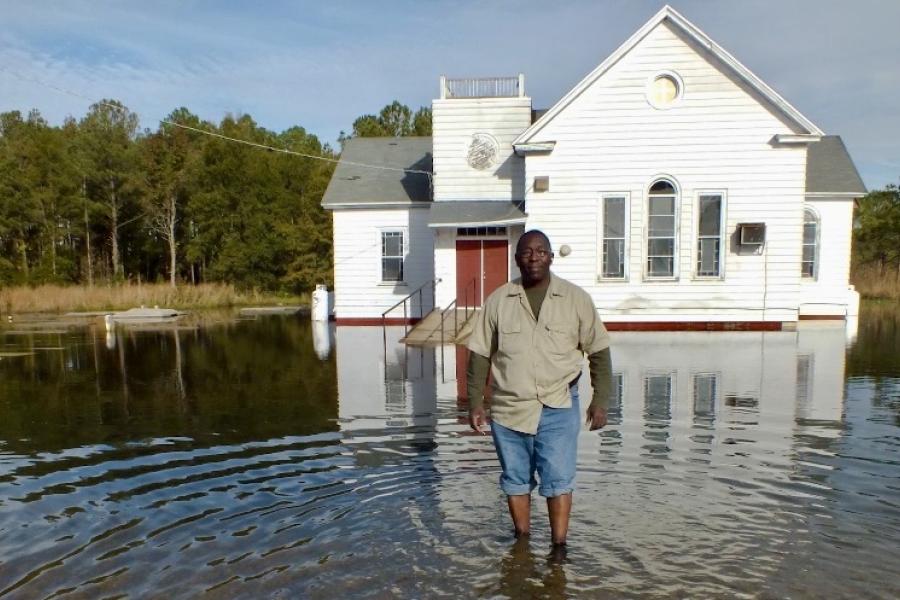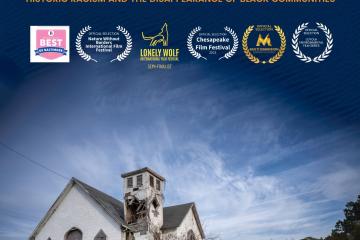The Deal Island Peninsula is shrinking. Slowly but inevitably. Like much of the land around the Chesapeake Bay, this marshy, hook-shaped section of Somerset County on Maryland's Eastern Shore is besieged by a double whammy: climate-change-induced sea level rise and subsidence, a natural form of land sinkage exacerbated by the excessive use of ground water. "Ghost forests" are expanding here—stands of trees killed by saltwater intrusion. For the 1,000 or so residents of this remote locale, it often means flooded properties and washed-out roads—all while waiting for the next big storm to hit and make things worse.
Veteran journalist and SNF Agora Visiting Fellow Rona Kobell is no stranger to this scenario. The Chesapeake Bay has been her beat and muse for some 20 years, as reporter for The Baltimore Sun and the Chesapeake Bay Journal, and managing editor of the Chesapeake Quarterly. When she first visited the peninsula a few years back, something else came into focus.
"It was very clear to me that while much of the peninsula was dealing with sea level rise and climate change, the Black communities were getting the worst of it," Kobell says. "You could just see their houses, churches, and gravesites were in worse shape. These communities already were at a disadvantage because they got the lower land to begin with. And now climate change was exacerbating their fate."
It is the fate of Black residents, particularly those in the small communities of Deal Island and Dames Quarter, that is the subject of the documentary film Eroding History, which debuted in April. Kobell co-produced and co-wrote the 27-minute film with Washington, D.C., photographer André Chung (who directed it) and Baltimore journalist Sean Yoes. The SNF Agora Institute is sponsoring a free campus screening and discussion about the film—which grew out of Kobell's thesis project for her MA in journalism at the University of Maryland— on Tuesday, Oct. 10.
Among the proud and determined folks Eroding History introduces viewers to is pastor Tony Johnson and the small congregation he leads at the Macedonia United Methodist Church in Dames Quarter. Storms and certain high tide events, he says, can leave his church surrounded by water and inaccessible to parishioners for weeks at a time. But then it hasn't succumbed to the fate of the John Wesley Methodist Church and its separate church hall further down the peninsula, both now water damaged and abandoned. Resting in peace is not easy in the graveyards here as residents describe floods that have caused coffins to emerge from the ground and float down the road.
The first European settlers here, Kobell says, were British "ne'er do wells" who used what was then called Devil's Island as a base of piracy. Then came more permanent settlement. "There were enslaved people on the island who worked on plantations and did other things, and some free Black people, as there were in many places on the Eastern Shore," Kobell says. Indeed, the Wesley Church's roots trace back to a formerly enslaved man named Arnold Wallace who bought his freedom.
After the Civil War, when Black families wanted to settle down, Kobell says, they were "pushed down the necks" by the white population—which is to say, relegated to the lowest, marshiest spits of land. "Low bottom land of high reeds and high mosquitoes," is how historian Vincent Leggett, a chronicler of the Bay's Black history, puts it in the film.
For all its unsettling tales and forlorn imagery of abandonment and decay, Eroding History is not without hopefulness and even joy. Gospel music forms much of its soundtrack, and the film ends with peninsula resident Chanelle White Acheamfour, a biology professor at Delaware State University, describing how grant funding is fueling the stabilization (and, hopefully, one day the full restoration) of the Wesley Church. "This church has been a beacon of the community since the 1800s, and our goal is to see that it will remain a beacon as long as Deal Island is here," Acheamfour says.
The film was created in association with the Environmental Justice Journalism Initiative, the Baltimore nonprofit Kobell co-founded in 2020 with community organizer Donzell Brown focused on revealing environmental inequities and empowering the disenfranchised to tell their stories.
"We have to make sure that everybody has clean air and clean water," she says. "But another part of it is that we want to make sure that the history of people who made important contributions to this country is not erased. And that's what I see on the Eastern Shore. A lot of Black communities are being erased. I'm so grateful to have this fellowship at SNF Agora because it's going to give me time to investigate more of these communities."
Posted in Arts+Culture, Politics+Society
Tagged climate change, documentary, chesapeake bay









